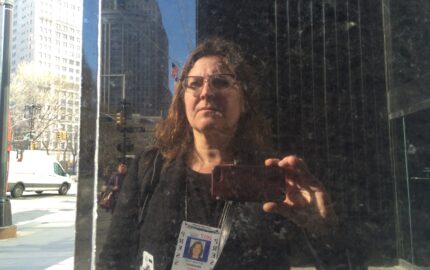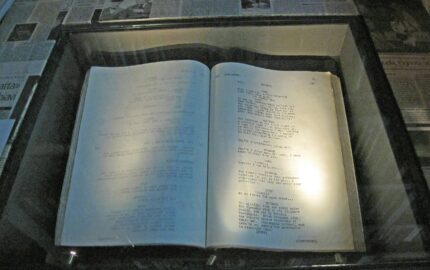Rotten Tomatoes didn’t think much of “The Da Vinci Code,” the 2006 film adapted from Dan Brown’s best-selling novel of the same name. The movie only rated 25 percent on the Tomatometer; the Critics Consensus called it “dull and bloated.”
I can’t argue that it belongs in any top-100 list of great movies. But I found it immensely watchable — and still click on it when I can’t sleep or am on an especially long flight. Sometimes the easy diversion of dull and bloated is just the comfort I need — like a grilled-cheese sandwich and tomato soup on a tired Friday evening. I also owe the movie a writing/editing insight that I continue to draw on all these years later, and that brings me to a red-faced admission of a fact error made in last week’s newsletter.
I’ll get to the latter in a moment. First, a scene from the movie that introduced me to the term “scotoma.” American historian and symbologist Robert Langdon (Tom Hanks) was on the run with French police cryptographer Sophie Neveu (Audrey Tautou) to solve a murder — and perhaps the mystery of the Holy Grail. They take temporary refuge with historian Sir Leagh Teabing (Sir Ian McKellen), who is obsessed with his own theories about the Grail. To make his case, Teabing has Neveu look at a projection of Da Vinci’s fresco, “The Last Supper,” then close her eyes and tell him what she saw. She says Christ and the apostles were drinking wine, and that there was one cup — the chalice that many believe to be the Holy Grail — on the table in front of Christ. Teabing then has her open her eyes and, voila!, no cup.
Not gripped yet? Then you may have missed the moment in the clip I link to above when Teabing mentions that Neveu’s closed-eye view was based on “scotoma” or, as he says: “The mind sees what it chooses to.”
The word was new to me, so I looked it up. It refers to a blind spot in the eye that can obscure or blur vision. If I understand it correctly, in some cases the brain can infer enough data to fill in the obscured area but precision is lost in the process.
Blind spots when writing or editing
What stuck with me from the movie was not the physiological definition of scotoma as much as a metaphorical one that applies to journalism. Consider again Teabing’s line: “The mind sees what it chooses to.” Then think of the times you have made baffling mistakes in copy. Maybe you misspelled a name or subbed the wrong name altogether. Or you knew the city council voted for a new ordinance, but you wrote that they voted against. Or your fingers typed one number when your brain knew it was a different one. The editor reading behind you — if there is one — either doesn’t know you got it wrong, or also sees it wrong.
This happened in a stark way when a newspaper I worked for published a story that included a reference to the three million Jews killed in the Holocaust. The story was written by a veteran reporter and went through at least four editors. Yet somehow the known fact of six million became three million — perhaps because all those fine journalists knew the right number so read that into the copy.
Or as my adaptation of Teabing’s line goes: The eye sees what the mind wants it to.
My eye does that more often than I care to admit. Small typos or duplicate words linger in copy that I’ve proofread multiple types. “It’s” is too often typed when I meant “its.” A letter is dropped from the proper spelling of someone’s name; I see the name in my mind as I know it is spelled — then see it the same on the screen.
Errors have many causes, of course, from poor sourcing to inadequate fact-checking to working too fast to making assumptions. But many are from mental scotoma — or what a former colleague simply calls “brain farts.”
It happens. And when it does, in ways big or small, it hurts.
Corrections and apologies
It happened to me recently when I edited Chip Scanlan’s Storyboard annotation of John Branch’s New York Times story “Ghosts on the Glacier.” I referred to Aconcagua, the mountain in Argentina that centered Branch’s story, as the second-highest peak in the world. I was soon corrected by a few Storyboard readers — for which I’m grateful and, as mentioned above, red-faced. I’ve hunted through all variations of the drafts I edited; the only thing that comes close is a reference to Aconcagua as the tallest mountain in the Western Hemisphere and the second tallest of the Seven Summits.
I’ve corrected the post on the Storyboard site. I apparently can’t correct MailChimp once it’s sent, so the February 9 newsletter carries the error forward. Gah! All I can do is acknowledge the error here, with apologies to Branch, Scanlan and Storyboard readers.
This rises nowhere near the top of errors that can creep into our work. Most people probably read right over my goof or weren’t interested enough in the geological details of Aconcagua to care.
But that’s not the point: The point is to acknowledge errors when we do make them — and we make them more and more often as we work faster, with fewer resources, across multiple platforms and as newsrooms lose the layers of crackerjack copy editors we once took for granted. Editing and proofing yourself is always fraught with slippage or, as I see it, an invitation to scotoma.
And a reminder to slow down, then read with fresh eyes.



